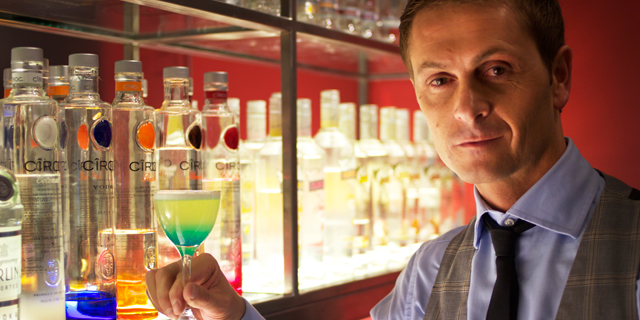Master mixologist David Rios is a busy man. Not only does he own three businesses – an event planning company, Café des Kobuk in Barakaldo, Spain, and The Jigger Cocktail & Disco Bar in Bilbao, Spain (which he co-owns with his brother) – he is also Diageo Reserve’s World Class Bartender of the Year 2013. Rios, who bested 44 other global finalists en route to claiming the prestigious title, is the first ever winner to hail from a Spanish-speaking country.
A twenty year hospitality veteran, Rios has worked as a bartender, maitre’d, and sommelier at some of the restaurant industry’s most renowned establishments, among them San Sebastian’s Mugaritz, rated No. 4 in this year’s World’s 50 Best Restaurants. Tonight, he’ll serve his liquid confections at the Latin Grammys, where he’ll be the event’s exclusive mixologist.
We sat down with Rios last week to get his take on current cocktail trends, tips for making the perfect drink, and a few of his favorite recipes.
What makes a great cocktail?
You must start with good ingredients and good products. From there it’s a matter of knowledge and respect for the ingredients, as well as attention to detail and the desire to do something well. But knowing your ingredients and their characteristics is key. This takes a lot of education.
Are there any definitive rules for pairing cocktails with food?
A lot of people like to recommend complementary flavors. I prefer contrast and impact. Sweet cocktails with sweet desserts are great, but to change the mentality and do whiskey with dessert is more interesting.
What is your inspiration for staying on top as a bartender?
I’m 37 years old. I have twins; a girl and a boy. And I own businesses and will open a new bar in three weeks. I think I was the only one in the Diageo contest that was older. The other bartenders were in their twenties, and perhaps didn’t have the responsibility or the experiences that I have. I’ve worked as a sommelier, a maitre’d, a bartender, and I worked at Mugaritz, one of the world’s best restaurants.
Also, I think my personality is such that I work hard every day and find inspiration in my kids and my family and my surroundings. It’s very important that every day you wake up with a dream and you chase that dream while keeping your feet on the ground. Sometimes it’s very difficult because I create so many new cocktails every day. For magazines in Germany and Peru and…but this is the challenge of being a world class mixologist.
Of the many cocktails you’ve created, which is your favorite?
The DreamCatcher. It was the first cocktail I made in Diageo’s World Class Contest. It was inspired by a trip I took to Scotland with my family – inspired by my wife, my kids, the castles and the countryside and the atmosphere in Scotland. It’s very special. I presented my drink in the contest in a diorama, with background Celtic music and a smoke machine to represent the fog of Scotland. The Dreamcatcher cocktail is the precursor to the DreamCatcher2 cocktail that I will serve at the Latin Grammys.
Next up, the most popular ingredients for 2014 and an official Latin Grammy’s cocktail…
[pagebreak]Have you noticed any trends in mixology?
If you are talking about global trends, there are a lot of differences among countries. For example, even something as simple as a garnish is not a given in every country. There are, of course, certain standards like the twist or the lemon wedge. But different places dress their cocktails and punches differently. Another trend, as with food, is molecular mixology. But I think that the biggest trend right now is towards simplicity. Not chasing trends but doing more with less.
What are you predictions for emerging cocktails and ingredients in 2014?
It’s a difficult question because it’s hard to isolate a single ingredient among so many options. It’s also hard to compare among cultures. Japan has a different drinking culture than Spain, for example. Where Yuzu might take hold in Japan, it would not catch on in Spain.
But certainly you see trends within cultures. Mezcal, for instance, is huge in the U.S. right now. Why does one “foreign” ingredient catch on and not another?
It’s hard to say. In the U.S. you have a drinking culture that is familiar with tequila, so mezcal is a natural extension of that. In Spain, Tequila doesn’t sell at all. In Latin America, nobody orders a classic cocktail. Something fruity with lots of fanfare and decoration is preferred. To change a culture is difficult. But little by little, it’s happening. A lot of it has to do with money, and as people have more money, they will be more adventurous and try new, often more expensive, things.
What are the essential ingredients for building an at-home bar?
Ice, glasses. No, but seriously, I would say you need your basic alcohols like rum, vodka, and gin, as well as mixers like juice and sodas. Then get some herbs like mint and rosemary and, of course, sugar.
We’re heading into the holiday season, which means a lot of celebrating. Do you have any tips avoiding a hangover?
One month before Christmas, drink every day. And then you will be prepared. I’m kidding, of course. Drink responsibly. But if you do drink too much, have a Bloody Mary and lots of water the next day.
Get a taste of what Rios will be serving up at the Latin Grammy’s with his recipe for Musica es Vida.
- 1 3/4 ounces Ciroc
- 1/3 ounce tangerine liquor
- 1/3 ounce simple syrup
- 2/3 ounce pineapple juice
- dash of bitter lime juice



![Making Mealtime Matter with La Familia: Easy Sofrito [Video]](https://thelatinkitchen.com/wp-content/uploads/2015/10/sofrito-shutterstock__0-500x383.jpg)
![Easy Latin Smoothies: Goji Berry Smoothie [Video]](https://thelatinkitchen.com/wp-content/uploads/2015/12/goji_berry-shutterstock_-500x383.jpg)
















![Fun and Fast Recipes: Fiesta Cabbage Salad [Video]](https://thelatinkitchen.com/wp-content/uploads/2015/11/fiesta_cabbage_slaw-shutterstock_-500x383.jpg)









